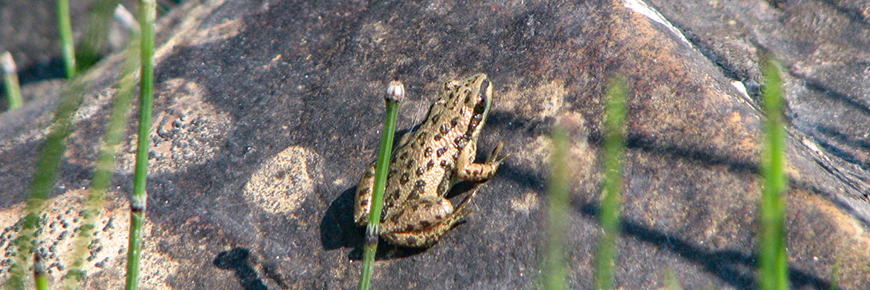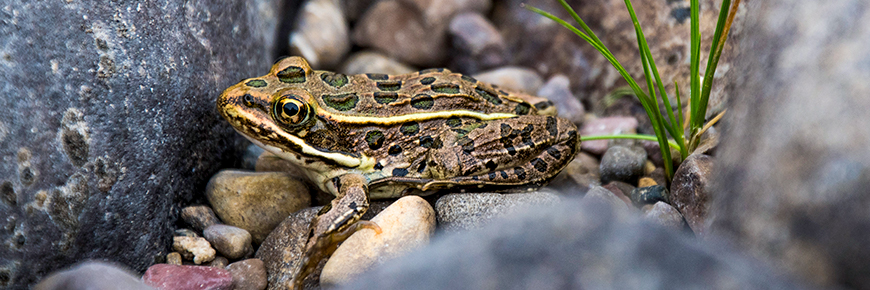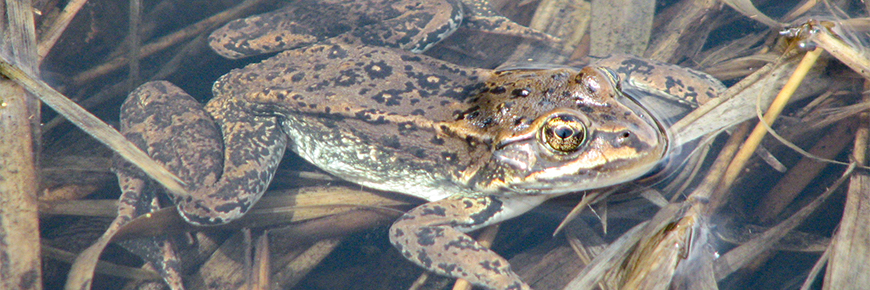Frogs and toads
Waterton Lakes National Park
Springtime is when amphibians are most obvious in Waterton Lakes National Park. Listen for their distinctive nighttime mating calls. The boreal chorus frog typically sounds the first notes of spring. All species live in the shallow, still waters of lakes and ponds. You may also spot western toads along some of the park's trails.
Drive carefully: Watch for amphibians on roadways, especially on rainy nights.
All frogs and toads are amphibians. They share many characteristics, but there are some distinct differences. Toads have thicker skin and are able to spend more time away from water than frogs. All species of frogs and toads lay eggs in water. The eggs hatch into tadpoles with internal gills. The tadpoles transform into juveniles with lungs and legs. This transformation is called metamorphosis.
Boreal (striped) chorus frog (Pseudacris maculata)

These tiny frogs (adults range from 2 to 4 cm) live up to their name. They produce a loud call that sounds like a finger running along the teeth of a comb. Listen for their overlapping calls near ponds in early spring.
The boreal chorus frog lives in Waterton Lakes National Park’s low-elevation wetlands. These wetlands situated in open grasslands and deciduous woodlands. This frog feeds on a variety of invertebrates.
Even though temperatures in Waterton Lakes National Park can reach a frigid -40 degrees Celsius, these frogs have a survival trick up their sleeve! They survive the harsh winter months by burrowing into moist soil near wetlands. Using natural sugars in their bodies, they produce their very own anti-freeze! Up to half of their fluid forms ice crystals in cold winter months. When you see the ice melting in the spring, remember these little frogs are thawing too!
Northern leopard frog (Lithobates pipiens)

Beginning in the 1970s, the northern leopard frog experienced a widespread population decline. This occurred throughout much of their historic range in western North America, including Waterton Lakes National Park. Northern leopard frogs were last observed here in 1980. The northern leopard frog (western boreal/prairie population) is designated a species of Special Concern under Canada’s Species at Risk Act and a Threatened species under Alberta’s Wildlife Act.
Since 2015, park staff have collaborated with Grasslands National Park and other partners to restore the species to part of their former range.
Learn more about this good news story: Research and monitoring initiatives in Waterton Lakes National Park.
Adult northern leopard frogs range in colour from brown to bright green and grow to be seven to 12 cm in length. Large, dark, leopard-like spots ringed in white cover their bodies and legs. Adult males make calls that sound much like a creaking door followed by a small chuckle.
Northern leopard frog tadpoles feed mostly on algae but also consume bacteria and small invertebrates. Adults are carnivorous and feed on anything they can fit in their mouths. Insects (beetles, flies, arachnids, crickets), earthworms and slugs are all on the menu. When the opportunity presents itself, they will also eat larger prey, such as small rodents.
Northern leopard frogs need three key habitats to fulfil their lifecycle:
- For breeding: a waterbody with shallow banks, adequate plant cover and direct sunlight
- For foraging and travelling: open areas near the waterbody
- For overwintering: a well-oxygenated waterbody that does not freeze to the bottom. They spend winters in the unfrozen water, absorbing oxygen through their permeable skin.
Ribbiting northern leopard frog facts:
- Females can lay up to 7,000 eggs per season
- Male northern leopard frogs get a swollen thumb pad during breeding season known as the “nuptial pad”
- Young northern leopard frogs may travel up to 8 km from the pond where they were born
- When fleeing danger on land, the northern leopard frog hops in a zig-zag pattern
- Northern leopard frogs are sometimes mistaken for the Columbia spotted frog; whose spots have a dark halo instead of a light one
Columbia spotted frog (Rana luteiventris)

The Columbia spotted frog is the most common and wide-ranging frog in Waterton Lakes National Park. It lives in valley bottoms upward through the lower subalpine ecoregion. They are similar in size and appearance to the northern leopard frog, and are often mistaken for them. Columbia spotted frogs lack white ridges along their backs. The spots on these frogs' backs have tiny, light-coloured centres. They also have white underbellies with a pink wash that extends from their underbelly to thighs.
At breeding ponds in spring, male Columbia spotted frogs utter low pitched calls sounding much like a distant helicopter. The species’ grapefruit-sized egg masses are sometimes laid in groups. The frog’s egg masses sometimes turn green, due to non-threatening algae.
Columbia spotted frogs are not able to coexist with fish such as trout. The introduction of trout at many waterbodies in the park in the 1900s resulted in local extirpation of many Columbia spotted frog populations. To date, these populations have not recovered. The Conserving Waterton’s Aquatic Communities project aims to restore Columbia spotted frogs and other amphibians to some water bodies affected by the introduced trout.
Western (Boreal) toad (Bufo boreas)

Western toads are designated as a Species of Special Concern under Canada’s Species at Risk Act. Like all amphibians, they are susceptible to changes in their environments. Even though western toads have been protected within Waterton Lakes National Park for more than a century, population declines have been observed in recent decades. When environmental effects (disease, pollution) take place on a global scale, they can still impact species whose habitats are otherwise safeguarded.
Despite what you might read in fairy tales, this toad is not covered in warts. They are covered with glands that produce a toxin to help ward off predators and pathogens. This toxin is not harmful to humans. Out of respect for any creature, it is best to never handle them (and handling wildlife is not permitted in national parks under the National Parks Act).
The western toad is the only amphibian in Waterton Lakes National Park that has visible glands located behind each eye, so they’re easy to differentiate from frogs. Another feature is their distinct, light-coloured dorsal (back) stripe.
Watch where you step, as toads may be underfoot! Toads have short legs and are better at walking than hopping. They tend to sit still and try to blend in with the background when in danger. Western toads’ thick skin allows them to spend much of their lives venturing far from bodies of water. The toads are in search of shelter and food like worms, slugs, and spiders. They’re sometimes seen foraging on roadways and trails at night – look out for them and give them the space they deserve.
In spring, a female toad may deposit long ropes of up to 16,500 eggs. The eggs are deposited in the shallows of ponds or lakes, usually in forested habitats. The eggs hatch into black-coloured tadpoles. Their pigment contains a toxin that makes them unpalatable to predators like fish. This makes western toad tadpoles well-adapted to living in waters that contain natural or introduced populations of trout.
Related links
- Date modified :